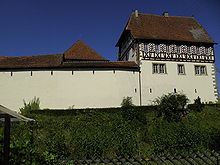Honhardt moated castle
The Honhardt Castle (also called the Honhardt Water Castle or the Honhardt Fortress) is a former moated castle in Honhardt that was built on a rock . It stands in the center of the village of Honhardt, formerly the seat of an independent municipality, today a suburb of the municipality of Frankenhardt in the Hohenlohe region in the Schwäbisch Hall district in Baden-Württemberg . The closed weir system with battlements was rebuilt after the destruction by the imperial city of Hall in 1444, later by this. The oldest part, the keep, is dated to the 11th century.
history
The 8th century is assumed to be the time of origin of the place. A first written mention of Honhardt can be found in a document from Emperor Heinrich II from 1024.
The first predecessor of the later castle , from which today's castle emerged in the 15th century , is also likely to have been built during this time. The complex initially consisted of the preserved keep, a residential tower , only surrounded by a palisade fence . In the period that followed, the fortification was expanded to a castle with the construction of a main house, the erection of a curtain wall with a battlement, the creation of a moat with a rampart and a drawbridge .
Honhardt was initially one of the two main towns of the Lohr rulership, along with Crailsheim . Around 1300 it passed into the possession of the Counts of Oettingen for a few years , but became Hohenlohisch as early as 1314 . In the 14th century the castle was the center of the Hohenlohe office of Honhardt and remained in the possession of the Hohenlohe family until the end of the century. At the same time, however, the Counts of Flügelau also owned shares in the Honhardt district. The Burgmannen were the 13th and 15th century niederadliges Ministerialengeschlecht , which called itself the Lords of Honhardt and vassals of then were the counts of Flügelau and von Hohenlohe.
In 1398 Ulrich von Hohenlohe sold the feudal sovereignty over Honhardt to Brandenburg-Ansbach and the place itself to the three imperial cities of Hall, Dinkelsbühl and Rothenburg . In 1399 the local ownership was completely transferred to the city of Hall, which in turn transferred ownership to two of their local patrician families . In 1413 they sold Honhardt together with the castle to the Lords of Bebenburg , servants of the Margrave of Ansbach . The castle was thus removed from the domain of the imperial city of Hall .
In 1444, in the course of the Bebenburg feud , a war between the imperial cities and the surrounding aristocratic rule, troops from Halle captured the Honhardt fortress and the castle was burned down and destroyed. After a lawsuit by the House of Bebenburg and the Ansbach margrave against Hall, a court settlement was reached in 1446, as a result of which the city subsequently bought the Honhardt office and the destroyed castle from the Bebenburgers in return for high compensation. In the same year, Hall transferred control of Honhardt to the Haller Spital . In the second half of the 15th century, this had a castle-like residential building built in place of the earlier castle and used it as a hospital office and the seat of the Honhardt office .
In 1677 Hall had the palace reinforced with palisades and the fortifications renewed. In 1700 the present main building of the castle was rebuilt. In the entablature in the hall, on the Gothic chimney on the first floor and on the corner stone on the south side, you can find the corresponding dates. Around 1730 the ornate plaster ceiling was in the piano nobile completed on the second floor. In the middle is a dove as a symbol for the Holy Spirit, the namesake of the hospital.
At the beginning of the 19th century, with the end of the imperial city of Hall, the castle became the property of the Württemberg state in 1803 and was used as the official seat of the Württemberg Oberamt Honhardt until it was opened in the Oberamt Crailsheim , which was founded in 1810 .
In 1815 the castle was sold to bourgeois buyers. Until 1980 the facility and its outbuildings were used as a rural property with livestock, stables and barns.
In 1981 the facility was renovated true to history. The Baden-Württemberg Chamber of Architects awarded a prize for "exemplary building".
description
The property consists of the main house, a side wing, the encircling battlement, a closed inner courtyard and the high medieval keep.
Todays use
In 2009 the castle was acquired by an art dealer and reconstructed. During this renovation, old building sins from previous uses were also consistently removed. Today the castle houses the art dealer's private weapons collection and sales rooms. The castle is not open to the public.
literature
- Alois Schneider: The castles in the Schwäbisch Hall district - an inventory . Konrad Theiss Verlag, Stuttgart 1995, ISBN 3-8062-1228-7 , pp. 92-95.
Individual evidence
- ↑ History of the place and castle at www.pro-region.de (PDF; 14 kB)
- ↑ Local history on the Frankenhardt community website ( Memento from December 29, 2015 in the Internet Archive )
- ^ The castle on the Frankenhardt community website ( Memento from June 5, 2016 in the Internet Archive )
- ↑ Press report of the Hohenloher Tagblatt from October 5, 2011 ( Memento from May 30, 2016 in the Internet Archive )
Web links
Coordinates: 49 ° 4 ′ 12 ″ N , 10 ° 2 ′ 20 ″ E



